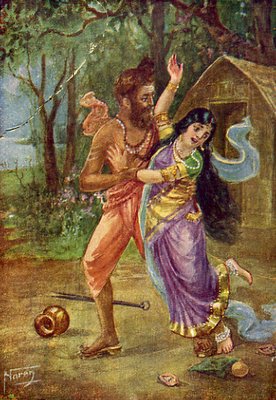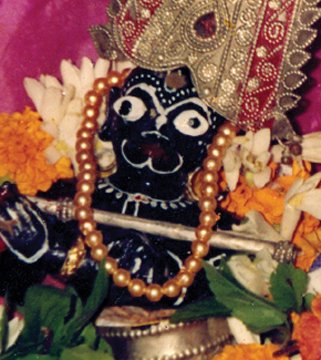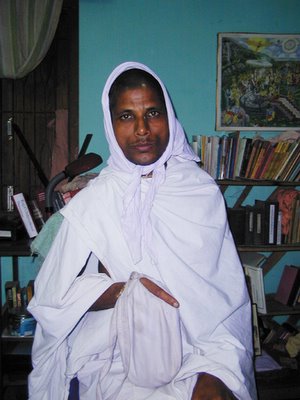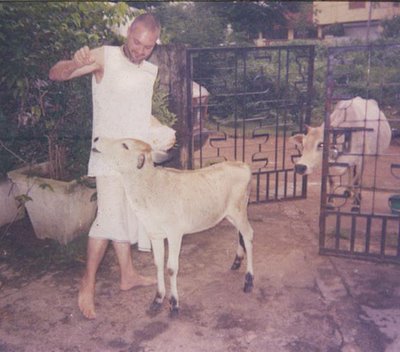By Madhavananda Das
The following article was something that we wrote for issue number 16 of Sri Krishna Kathamrita Bindu.
In Hari-bhakti-vilasa, verse 2.147, Srila Sanatan Goswami quotes Sammohana-tantra:
gopayed devatam istam gopayed gurum atmanah
gopayec ca nijam mantram gopayen nija-malikam
One should hide one’s ista-deva, one should hide one’s guru, one should hide one’s mantra, and one should hide one’s japa-mala.
Wise persons keep their valuables in a confidential place. Similarly, an intelligent sadhaka does not advertise his or her guru, nor do they broadcast themselves as disciples of their guru. Considering themselves as low, fallen, and unfit to be considered disciples, sincere devotees do not want to advertise who their guru is.
Srila Krishnadas Kaviraj Goswami has illustrated the mood of a devotee and disciple:
jagai madhai haite muni se papistha
purisera kita haite muni se laghistha
I am more sinful than Jagai and Madhai and even lower than the worms in stool. (Cc. adi 5.205)
Similarly, Thakur Bhaktivinode has stated:
garhita acare, rahilama maji’,
na karinu sadhu-sanga
laye sadhu-vesa, ane upadesi,
e bada mayara ranga
Remaining absorbed in abominable activities, I never kept company with sadhus. Now I adopt the garb of a sadhu and act out the role of instructing others. This is maya’s big joke. (Saranagati 7.3)
Although Thakur Bhaktivinode had so much association with elevated vaisnavas, including his siksa-guru Jagannath Das Babaji Maharaja, he did not flaunt that. Rather, he considered that, na karinu sadhu-sanga — “I have never had association with sadhus”.
The essential principle in being a disciple is to follow the order of the guru. Srila Krishnadas Kaviraj Goswami has described:
acaryera mata yei, sei mata sara
tanra ajna langhi’ cale, sei ta’ asara
The order of the spiritual master is the active principle in spiritual life. Anyone who disobeys the order of the spiritual master immediately becomes useless. (Cc. adi 12.10)
Similarly, it is stated in the Raghu-vamsa:
sa susruvan matari bhargavena
pitur niyogat prahrtam dvisad-vat
pratyagrhid agraja-sasanam tad
ajna gurunam hy avicaraniya
Being ordered by his father, Parasuram killed his mother, Renuka, just as if she were an enemy. When Lakshman, the younger brother of Lord Ramachandra, heard of this, He immediately engaged Himself in the service of His elder brother and accepted His orders. The order of the spiritual master must be obeyed without consideration. (verse 14.46, quoted in Cc. madhya 10.145)
Srila Thakur Bhaktivinode has described that there are two types of disciples, the antarmukha-sisyas and the bahirmukha-sisyas. Antarmukha literally means “inward-facing”. It refers to someone who is introspective. Bahirmukha literally means “outward-facing”, and refers to someone who is absorbed in external things.
Antarmukha-sisyas are desirous of bringing pleasure to their guru. Their focus is on following the guru’s instructions. The antarmukha-sisyas practice gopayed gurum atmanah. They keep their guru and their relationship with him confidential. An antarmukha-sisya is not interested in advertising himself as a disciple of his guru, but prefers to follow the guru’s instructions. His meditation is to try to understand what will please his guru. The antarmukha-sisya is anartha-mukta-avastha, he is free from anarthas. His vision of guru is known as sevya-darsana. He sees that guru should be served and pleased.
Bahirmukha-sisyas are disciples who practice the opposite of gopayed gurum atmanah. They are absorbed in advertising their guru and in making a show of themselves as being big or intimate disciples. Such a disciple is also known as guru-giri, or one who makes a business out of guru and one’s relationship with guru. They are not absorbed in the inner intention of guru. Srila Bhaktivinode Thakur has described persons who act on such an external platform as dharmadhvajis (“religion flag-wavers”), meaning those who make a hypocritical or pretentious show of religiosity.
Following the logic of atmavan manyate jagat (everyone thinks like I do), the bahirmukha-sisyas consider that their guru thinks like they do. Because they are motivated by the desires for fame and adoration they think that their guru also wants such things. The bahirmukha-sisyas are anartha-yukta-avastha, they have anarthas, material desires, in their hearts. Because of those anarthas they only see guru in terms of their own pleasure. This vision is known as bhogya-darsana. They think that making a big show of devotion will impress their guru and enable them to come close to their guru. Their idea of guru-bhakti is to loudly proclaim to the world, amar guru jagad-guru — “My guru is the best or the only one and any other guru is lesser.” They think that such publicizing will please their guru. Neglecting or minimizing their guru’s instruction regarding the worship of
In the histories of all the major religions of the world it is commonly seen that the followers prefer to worship the guru, prophet, or founder rather than follow the instructions of that prophet to worship the Lord (who is unseen and unknown to them). Srila Prabhupada addressed this topic on a morning walk in
Devotee: In
Prabhupada: Just see.
Indian man (1): No, they are also Krishna-bhaktas.
Devotee: How are they, if they are chanting Swami Narayan’s name?
Indian man (1): They actually work for the
Prabhupada: No, no.
Indian man (2): Swami is their guru and Narayan is God, so both, Prabhupada and
Prabhupada: But that does not mean they should chant [like that]. Just like, we are not instructing our disciples to chant my name, “Bhaktivedanta Swami, Bhaktivedanta Swami.” No. They’re chanting Hare Krishna. hari-tvena samasta-sastrair uktah — “Guru is respected as good as
— Srila Prabhupada morning walk,
Although the antarmukha-sisyas, who follow the instructions of guru, get the full blessings of guru, the bahirmukha-sisyas do not get the proper result. In this connection Srila Jagadananda Pandit has written:
gorara ami gorara ami mukhe balile na cale
torara acara gorara vicara laile phala phale
It is not enough to repeatedly advertise that one is a devotee of Mahaprabhu by saying, “I am Gaura’s! I am Gaura’s!” Rather, those who follow the practices taught by Mahaprabhu are understood to get the results of being the Lord’s follower. — Prema-vivarta 8.6
Sometimes we see that bona fide spiritual masters allow themselves to be advertised in order to preach. However, this is done in service to Chaitanya Mahaprabhu. Such personalities are not materially desirous of receiving prestige from their disciples. The daksina, gift, that the guru wants is jnana-sandesah — the sincere search for spiritual knowledge (Bhag. 11.19.39).
As the ideal guru, Sri Chaitanya Mahaprabhu has taught us how to please the spiritual master. Mahaprabhu instructed His followers:
yadi ama prati sneha thake sabakara
tabe Krishna-vyatirikta na gaibe ara
If you really love me, then you should love My instructions: Don’t think of anything but
Understanding that his spiritual master is always with
yo mantrah sa guruh saksad yo guruh sa harih svayam
One should understand that the mantra one has received from the guru is identical with the guru and that the guru is identical with Lord Hari. (cited in Srila Jiva Goswami’s Bhakti-sandarbha, anuccheda 237.8)
Srila Rupa Goswami has described:
atha guroh sri-pada-dvandva-bhaktim
The holy name gives devotion to the guru. (Padyavali text 24)
Historically, the sadhu-samaja, the society of saintly vaisnavas, has never been impressed with mere external shows of devotion. They are moved, however, when they see the genuine vaisnava humility and other good qualities that have manifest in a devotee due to that devotee’s dedication to the instructions and bhajan given by guru (guru-nistha). Hence, introspective devotees prefer to keep their guru hidden and glorify him by exhibiting exemplary behavior.
For some devotees, pushing their guru is an easy way to avoid facing the reality of their own lack of advancement. They want respect, and they think it is easier for them to get it by broadcasting themselves as a disciple of a great personality than for themselves to manifest the qualities of a vaisnava. However, this kind of cheating mentality will never attract the attention of saintly persons. They are not impressed with whom we have taken initiation or instructions from. Rather, they want to see what is our own level of realization.
Since such neophytes equate the showing of respect to themselves with the showing of respect to their guru, when they become chastised or fail to receive the honor and recognition they want, they accuse the devotees, “You have offended my guru!” In this way, Kali, the personification of this age of quarrel and hypocrisy, is able to enter the movement of Sri Chaitanya Mahaprabhu and cause dissension, distracting them from their real business of chanting and distributing the holy names.
So Srila Sanatan Goswami’s instruction gopayed gurum atmanah — “One should hide one’s guru” — is advising devotees to go deeper in their relationship with guru by basing that relationship on following the instructions about service and bhajan that their guru has given.




















